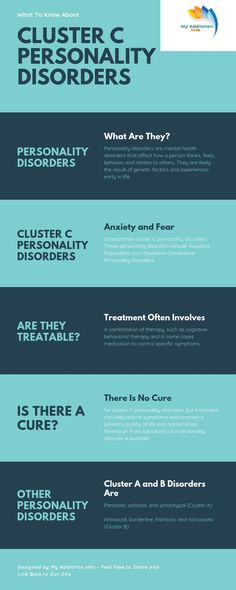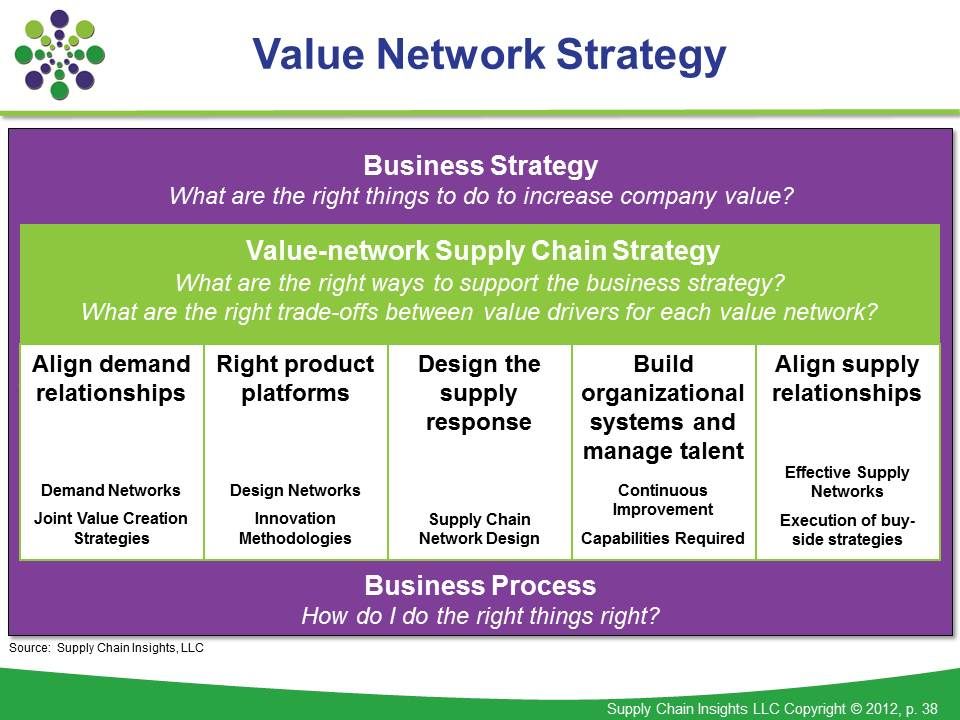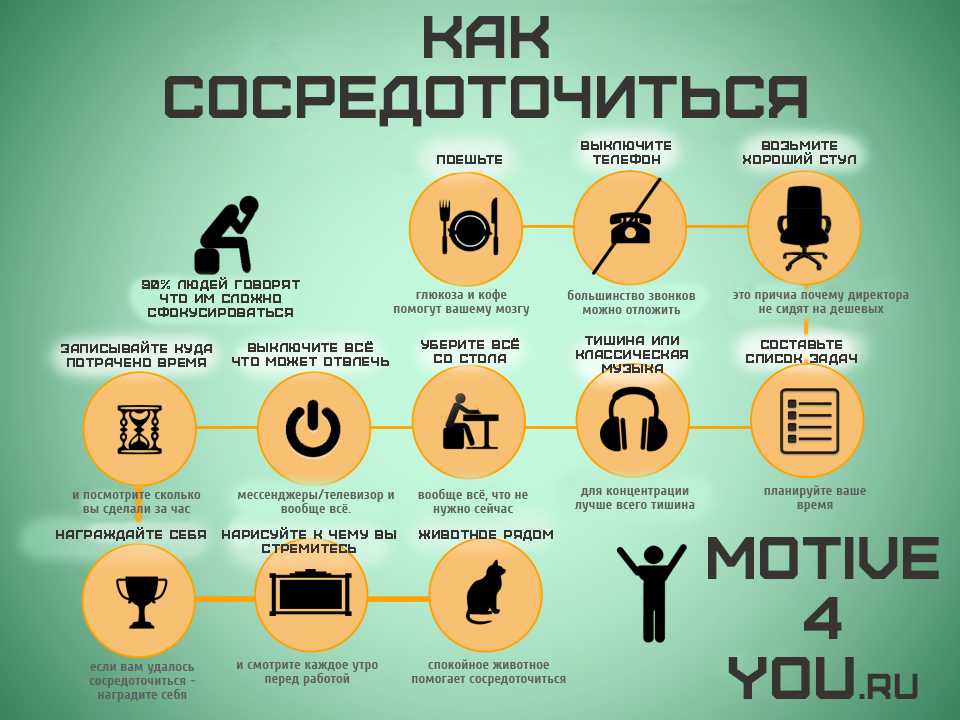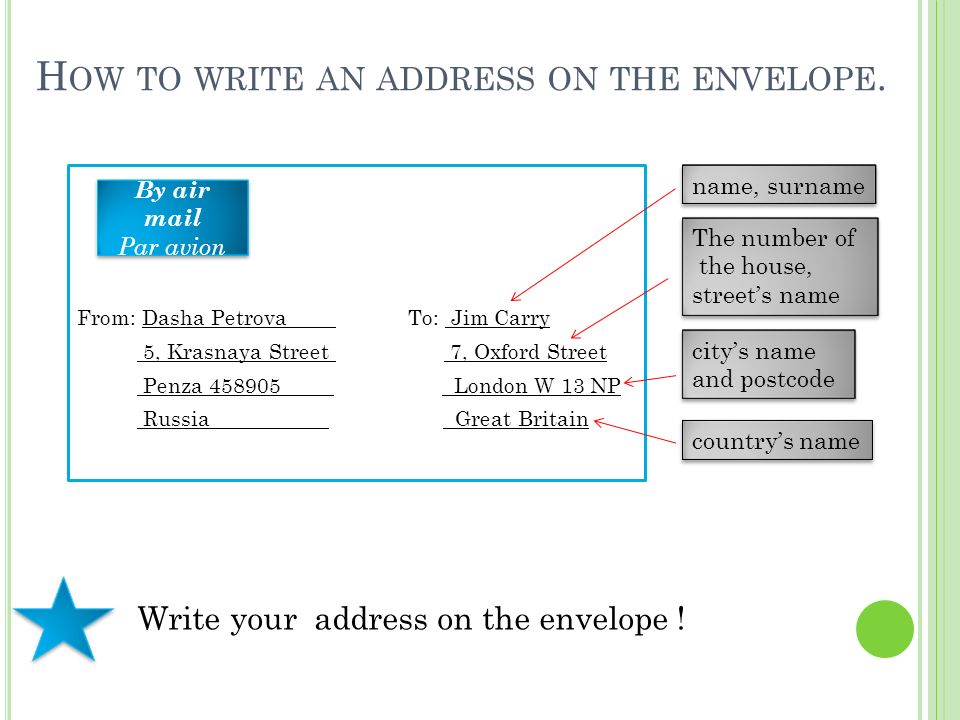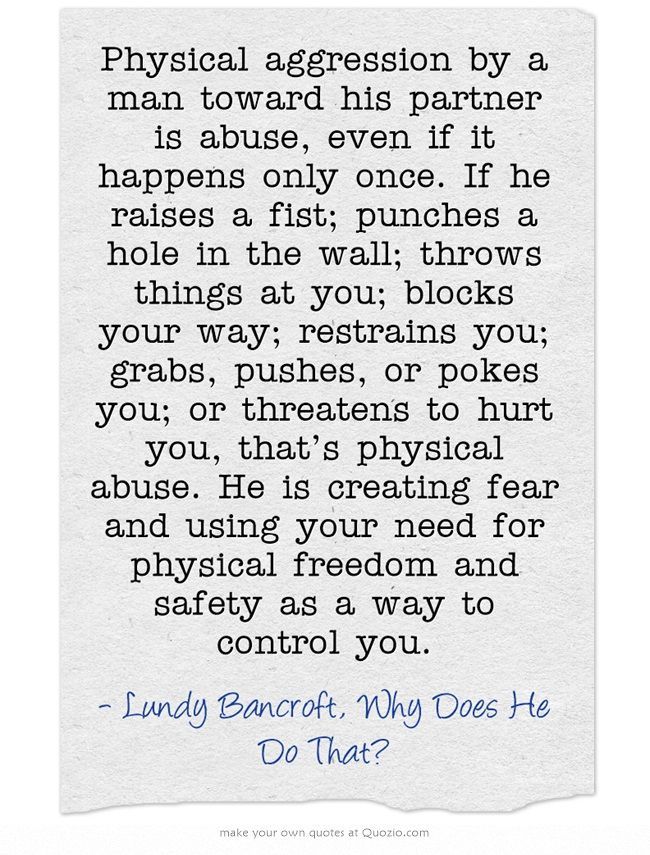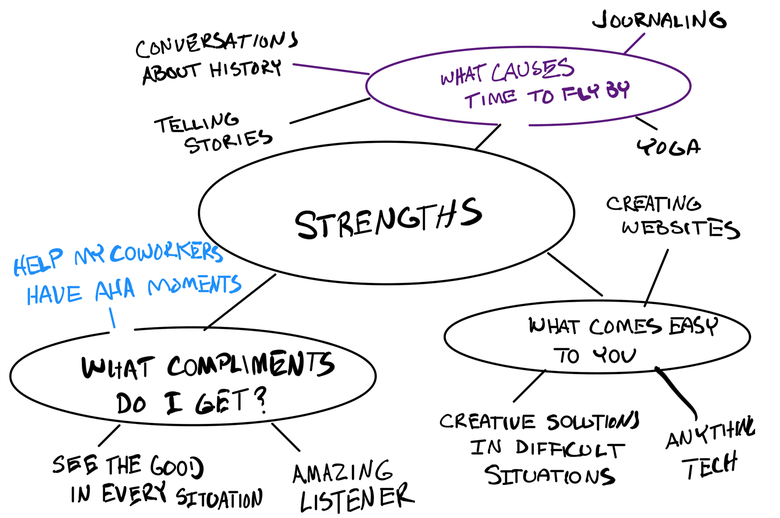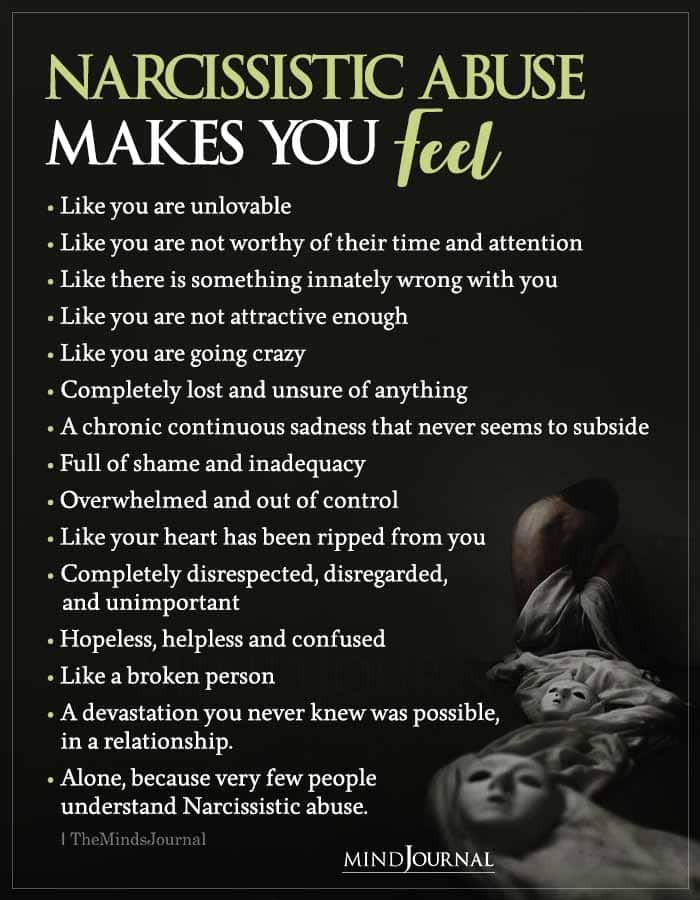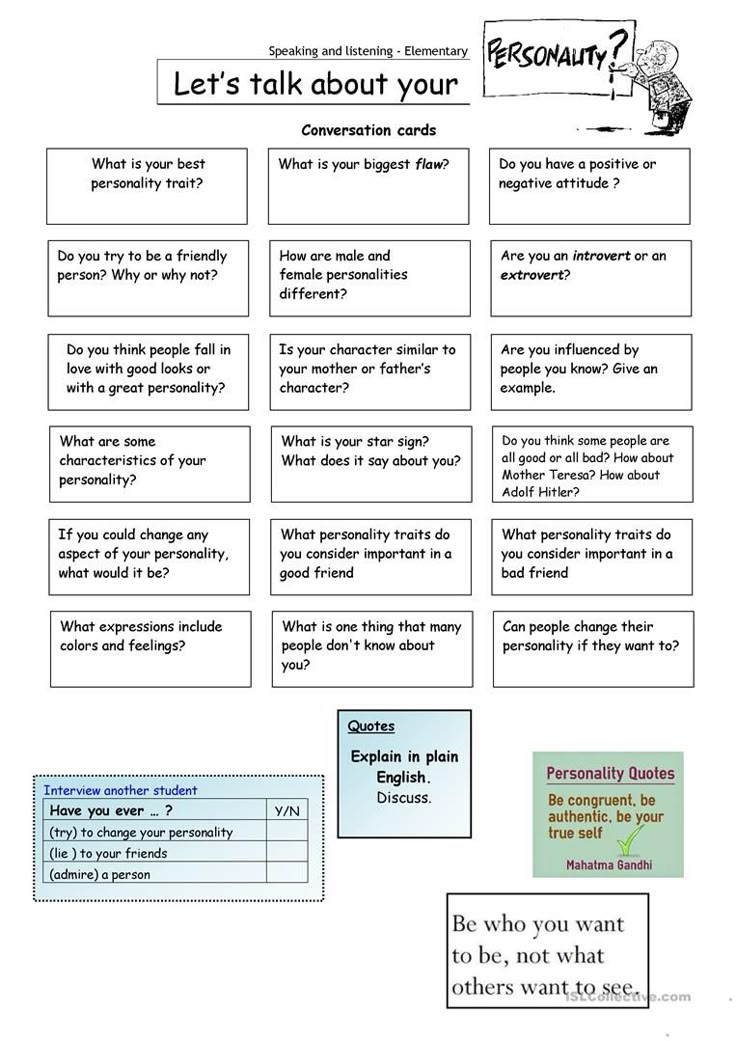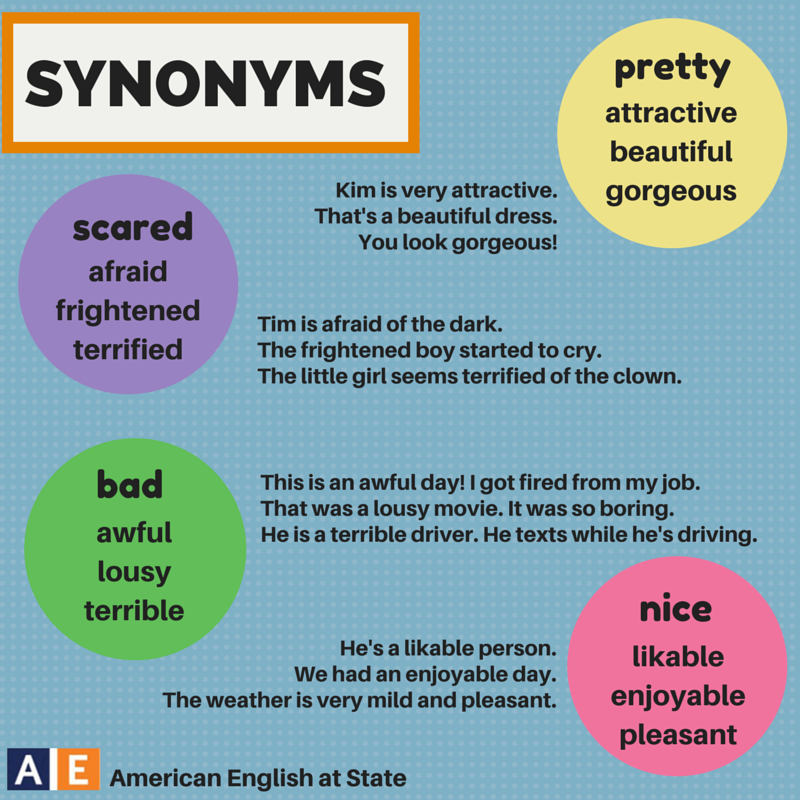How to deal with cluster b personality disorders
Cluster B Personality Disorders: Types, Symptoms, and Treatment
There are four cluster B personality disorders: antisocial, borderline, histrionic, and narcissistic.
Personality disorders are deeply ingrained, distressful ways of thinking, feeling, and acting that stray from standard cultural expectations of how people typically think, feel, and act. And folks who live with them experience unique challenges when it comes to navigating relationships, work, and life in general.
The cluster B personality disorders are grouped together because they share traits, including behaviors that others consider dramatic or overly emotional, trouble maintaining relationships, and significant distress.
The Diagnostic and Statistical Manual of Mental Disorders, 5th edition (DSM-5) categorizes the 10 personality disorders into three clusters:
- cluster A: paranoid, schizoid, schizotypal
- cluster B: antisocial, borderline, histrionic, narcissistic
- cluster C: avoidant, dependent, obsessive-compulsive
The National Institute of Mental Health (NIMH) notes that personality disorders affect 9. 1% of people. And according to the DSM-5, cluster B personality disorders are the rarest of the three, with a prevalence of 1.5%.
Learning the similarities and differences between the cluster B conditions can help us destigmatize these often misunderstood mental health conditions and better understand those who live with them.
Each cluster of personality disorders features similar characteristics.
The main traits shared among cluster B personality disorders are:
- dramatic, overly emotional, or erratic behaviors
- difficulty maintaining healthy, stable relationships
- traits that cause distress and impairments among those affected
- impulsive behaviors or self-destructive tendencies
- challenges finding effective treatment options
- possible co-occurring mental health conditions
According to the NIMH, race or sex doesn’t have any impact on the prevalence of personality disorders.
Antisocial personality disorder is characterized by persistent disregard for or violation of other people that begins in childhood and lasts throughout life.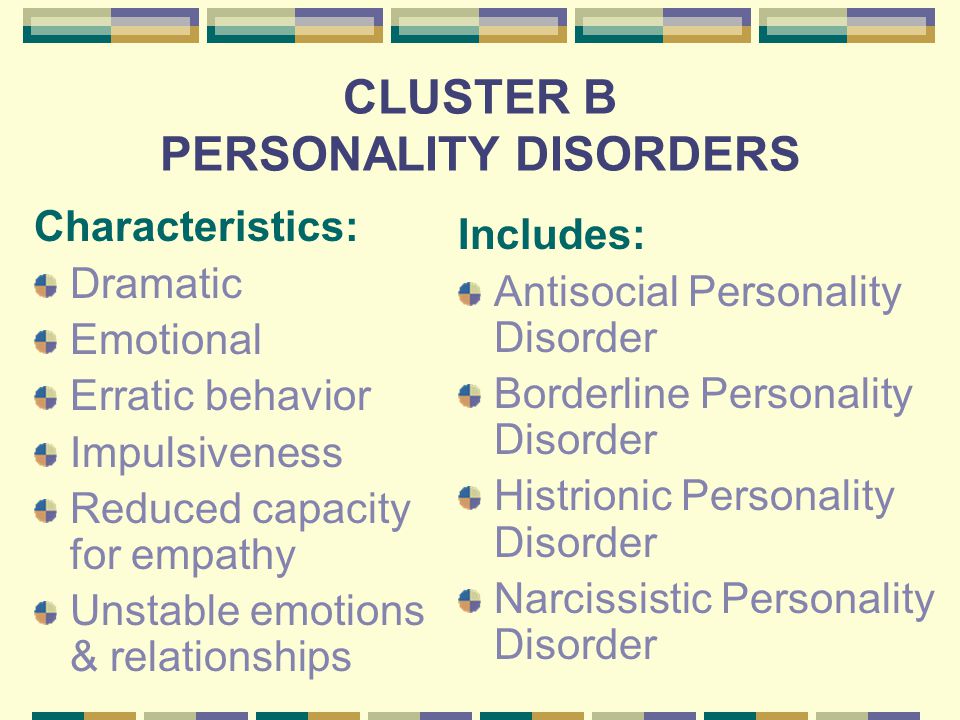
This condition has also been informally called or known as:
- psychopathy
- sociopathy
- dyssocial personality disorder
Psychopathy and sociopathy are unofficial and often misunderstood terms. Referring to the official diagnosis instead — antisocial personality disorder — affords a clearer and less stigmatizing understanding of the condition.
According to the DSM-5, you must be over 18 years old to receive an official diagnosis, but have a history of displaying related behaviors before age 15.
Signs and symptoms
Common antisocial personality disorder symptoms include:
- deceitful and manipulative tendencies
- aggression toward animals and people
- destruction of properties or belongings
- frequent breaking of rules and laws
- tendency to lie or con others
- irritability or argumentativeness
- disregard for safety
- lack of responsibility
- placing blame on others for your actions
- lack of empathy for others
The DSM-5 notes that people with antisocial personality disorder may also have the following co-occurring mental health conditions:
- anxiety disorders
- depressive disorders
- substance use disorders
- attention deficit hyperactivity disorder (ADHD)
Potential causes
Many folks who receive a diagnosis of antisocial personality disorder also have a parent with the condition.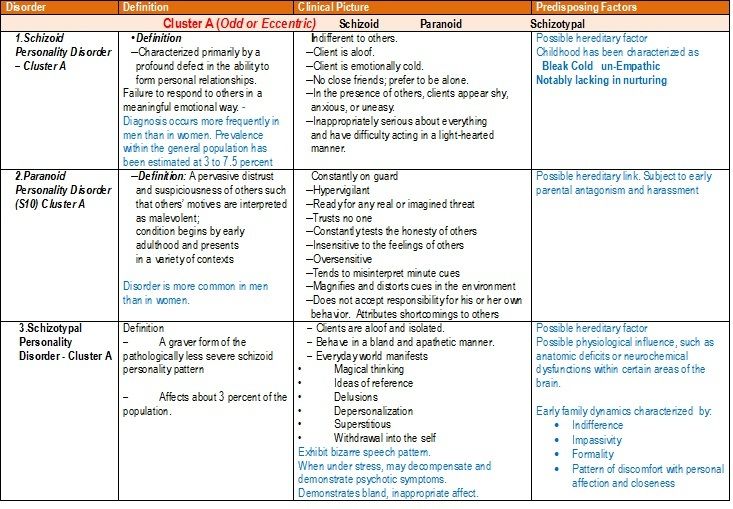 Men are among the most commonly affected.
Men are among the most commonly affected.
A 2019 study suggests that people with adverse childhood experiences (ACEs), like abuse or neglect, were more likely to develop antisocial personality disorder.
Socioeconomic or sociocultural factors, like poverty or migration, can increase the likelihood of someone developing this condition as well.
“There are both genetic and environmental influences on developing this disorder, but it’s important to remember that behaviors may mimic those in individuals who use antisocial behavior as a protective strategy for survival,” says Elinor Bawnik, LMFT, who works with people with personality disorders in Los Angeles, California.
According to the DSM-5, borderline personality disorder (BPD) is typically characterized by a pattern of unstable relationships, self-image, and impulsivity.
A 2018 study notes that the rate of BPD within the general population is 1.7%. Women are more commonly diagnosed with this condition compared to other identities.
Signs and symptoms
The most common symptoms of BPD include:
- intense fears of abandonment (either real or imagined)
- impulsive tendencies that can be harmful or damaging
- sensitivity to environmental circumstances
- unstable and intense relationships
- unstable sense of self or identity issues
- feelings of emptiness
- angry outbursts and difficulty managing anger
- anxiety or depressive symptoms
- severe dissociative symptoms
- dramatic shifts in perception of situations and people
- recurring self-harm and suicide attempts
Self-harm is very common among people who live with BPD. A 2019 study reports that up to 10% of people with BPD will die by suicide, despite treatment efforts.
If you or someone you know is considering suicide, you’re not alone. Help is available right now:
- Call the National Suicide Prevention Lifeline 24 hours a day at 800-273-8255.
- Text “HOME” to the Crisis Textline at 741741.
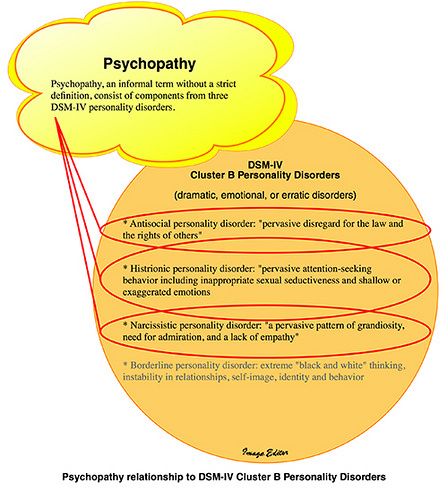
Not in the U.S.? Find a helpline in your country with Befrienders Worldwide.
Potential causes
According to Bawnik, BPD is typically associated with a traumatic, invalidating, dismissive, or unstable upbringing.
It’s commonly diagnosed among people with childhood histories of:
- physical and sexual abuse
- neglect
- hostile conflict
- early parental loss
BPD can also occur alongside other mental health conditions, like:
- bipolar disorder
- substance use disorder
- eating disorders
- post-traumatic stress disorder (PTSD)
- other personality disorders
Histrionic personality disorder (HPD), sometimes called dramatic personality disorder, features a pattern of excessive attention seeking and high emotions that present in various ways.
Signs and symptoms
A person might have histrionic personality disorder if they display five or more of the following symptoms:
- feeling uncomfortable or unappreciated when they’re not the center of attention
- interacting in inappropriate sexual or provocative ways with others based on the cultural context, such as at work
- having rapid shifts and a shallow expression of emotions
- using their appearance to attract attention
- exaggerating and dramatizing expressions
- being easily influenced by people and circumstances
- believing their relationships are more personal or intimate than they truly are
People with this condition are often flirtatious, seductive, enthusiastic, and charming.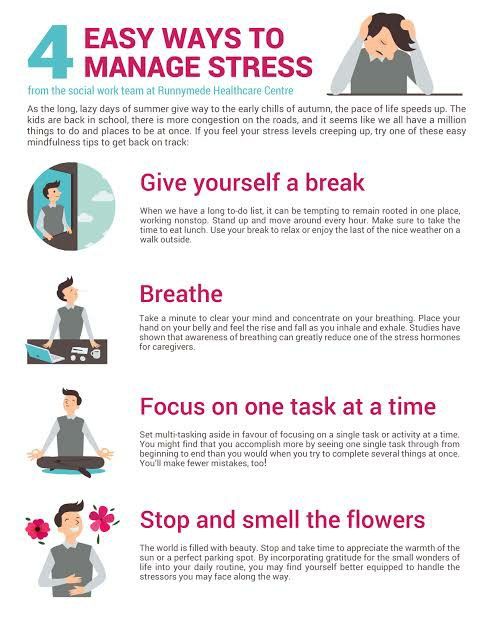 And when they’re not the center of attention, they tend to do whatever it takes to get the focus back on them.
And when they’re not the center of attention, they tend to do whatever it takes to get the focus back on them.
These attention-seeking behaviors can include:
- making up stories
- crying uncontrollably
- lashing out
Potential causes
HPD is more commonly diagnosed in women. However, this may be partly because it’s less socially acceptable for women to be sexually forward.
Experts believe the causes of histrionic personality disorder may be learned, inherited, or both. Underlying factors can be trauma related, leading to HPD symptoms as adaptive coping mechanisms.
Parenting styles can also play a major role in someone developing this personality disorder. A person may be more likely to develop it if their parents:
- lacked boundaries
- modeled dramatic, volatile, or inappropriate sexual behavior
- have a history of personality disorders or other mental health conditions
Narcissistic personality disorder (NPD) is typically characterized by grandiose behaviors, a need for admiration, and a lack of empathy for others.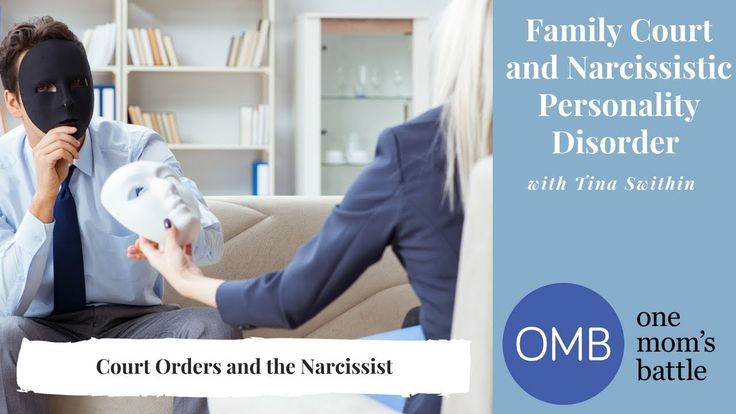
Although narcissism is a buzzword nowadays, NPD is actually very rare. According to the DSM-5, estimates of NPD in the U.S. population are anywhere from 0 to 6.2%, with 50–75% of those diagnoses in males. This data is older, though, and based on DSM-4 criteria.
Signs and symptoms
The most common signs and symptoms of narcissistic personality disorder include:
- grandiosity or exaggeration
- preoccupation with fantasies of great love, power, or success
- a sense of entitlement
- a need for excessive admiration from others
- beliefs of being “special” and needing to only associate with other high-status people
- exploitation of others
- a lack of empathy
- envy of others
- arrogant behaviors or attitudes
- an overestimation of achievements and abilities
“They can be very vulnerable, as their self-esteem is extremely low and will be reactive and sensitive to real or perceived criticism or defeat,” adds Bawnik.
Folks with NPD are often very charming and engaging, too. They want you in their world, so you can make them feel good about themselves.
It’s common for people with NPD to hurt others. This is because the person with the diagnosis doesn’t have the capacity for empathy or compassion for those around them.
Potential causes
Research from 2021 suggests that causes of NPD are multifaceted, including:
- genetic predisposition
- aggressive traits
- negative developmental experiences, such as trauma or abuse
- being rejected as a child
- having a fragile or hurt ego during childhood
- excessive praise from caregivers
Research is limited on effective treatments for cluster B personality disorders. But there are many options that can help you cope and manage the symptoms.
Some ways to manage Cluster B personality disorder include:
- medication
- psychotherapy or talk therapy
- behavioral therapies including:
- cognitive behavioral therapy (CBT)
- dialectical behavioral therapy (DBT)
- acceptance and commitment therapy (ACT)
You may also find relief by treating other symptoms and co-conditions, like anxiety, depression, or substance use disorder.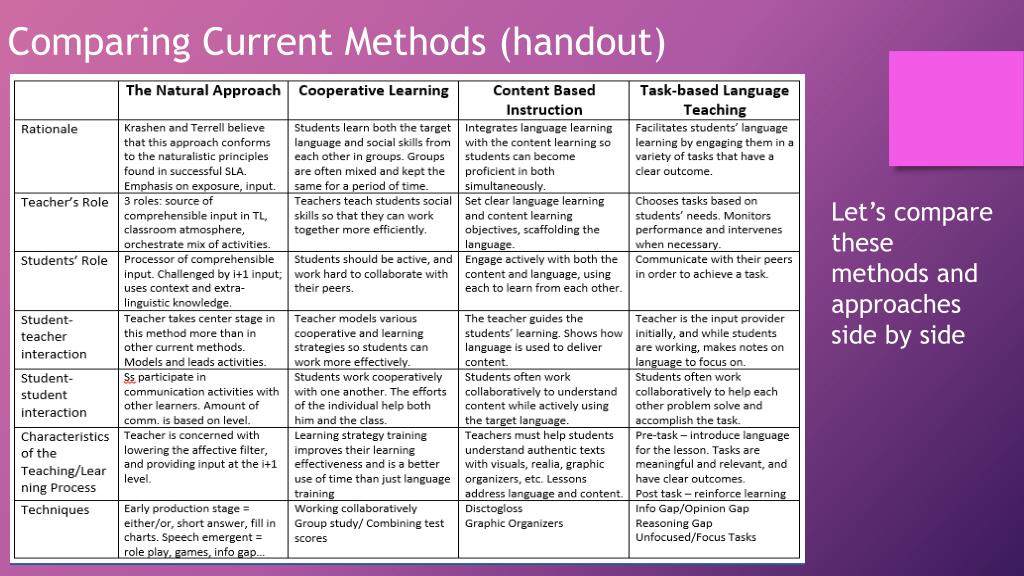
Bawnik offers the following tips and reminders to consider
- Be patient and remember your positive qualities.
- Improve your communication skills.
- Address your needs.
- Create boundaries as necessary.
- Try different treatment methods and coping mechanisms.
“Make sure you have a good support network to talk to when it’s been a rough day or just [need] a breather, including family, friends, therapists, neighbors, spiritual community, etc.,” she says.
Bawnik believes the secret to treating BPD lies in:
- building skills
- changing patterns
- communicating effectively
- regulating emotions
She says that the road to addressing these symptoms can be long and challenging, but it’s possible to find relief and heal.
A treatment option that works for one person may not be right for someone else, so consider working with a mental health professional or treatment team to figure out a good treatment plan for you.
If you ever feel suicidal or at risk of harm, remember that help and support are available. You can reach out to advocates and mental health professionals at a suicide hotline.
The cluster B personality disorders include the following four conditions:
- antisocial personality disorder
- borderline personality disorder
- histrionic personality disorder
- narcissistic personality disorder
They all share similar traits, but each have their own unique set of symptoms.
If you live with a cluster B personality disorder, trust that you can find relief and manage your condition. Treatment options like psychotherapy and medication may help you find more stability in your life and achieve healthier relationships.
It may take time to heal and overcome challenges related to these conditions. But healing is possible, support is available, and you’re never alone.
4 Ways to Interact with People Who Have Cluster B Personality Disorders
',$(a).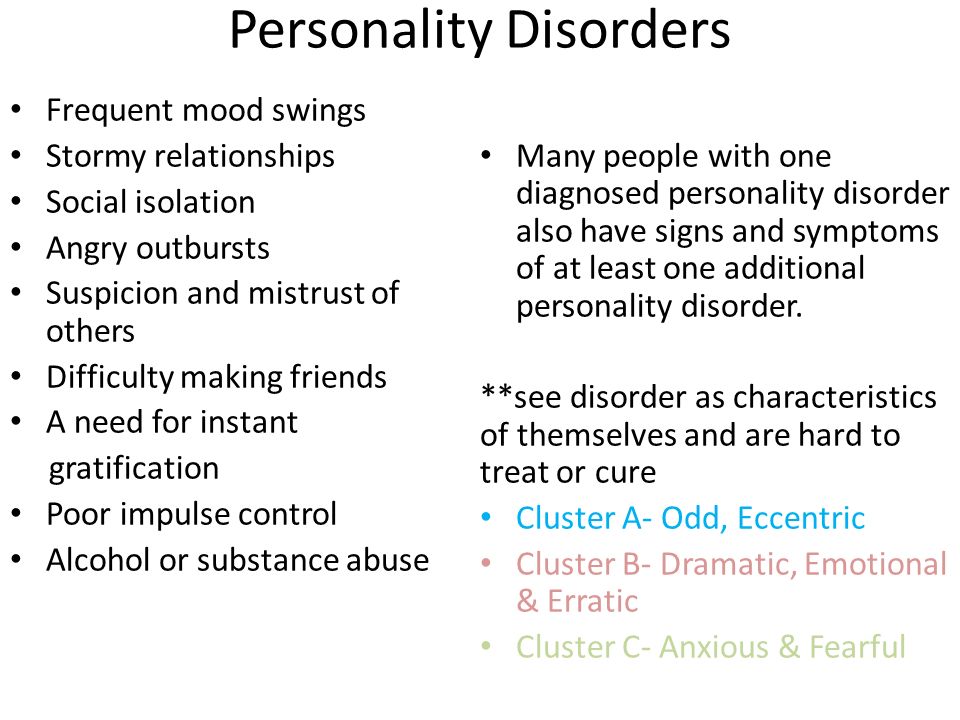 appendTo("#quiz_small_affiliate_placeholder"),$(a).insertBefore(".youmightalsolike"),a='
appendTo("#quiz_small_affiliate_placeholder"),$(a).insertBefore(".youmightalsolike"),a='
',$("#quiz_top_wrap").append(a),$('
').insertBefore("#newsletter_block_main"),la(!0),c=document.getElementsByClassName("scrolltomarker"),a=0;a
Download Article
Explore this Article
Download Article
People with Cluster B personality disorders can appear dramatic, confusing, or even emotionally manipulative. You may be unsure how to get along. If you have a friend, partner, family member, or coworker with a Cluster B disorder, you'll have to figure out a way to mindfully engage with them. Even so, communication with them may always be somewhat rocky. However, you can make use of a few strategies and avoid potential landmines.
Steps
-
People with Cluster B personality disorders are often dramatic, emotional, and unpredictable.
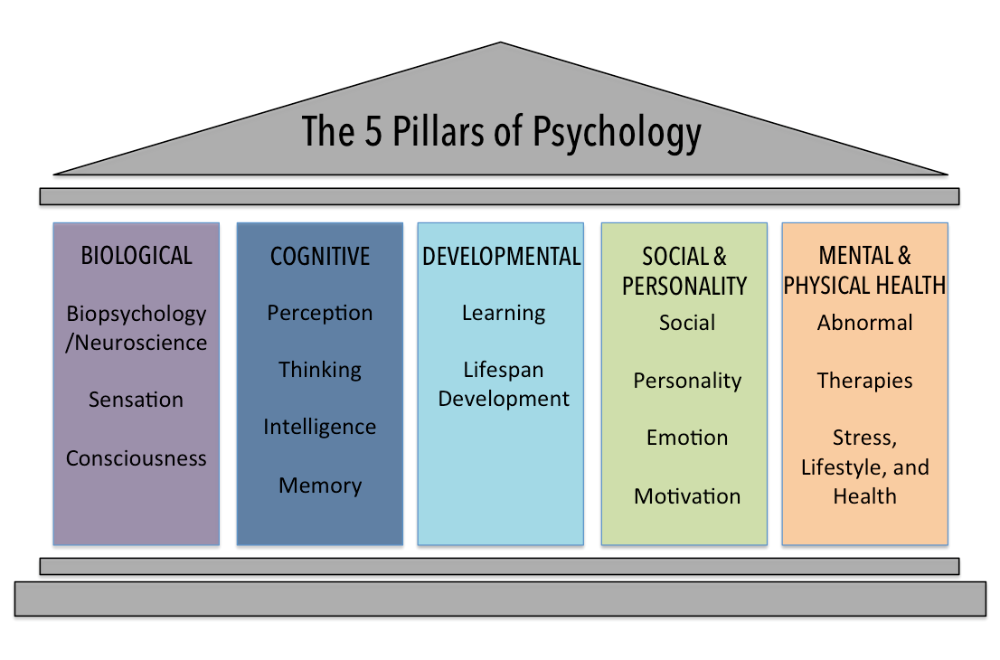 Cluster B personality disorders include antisocial personality disorder, borderline personality disorder, histrionic personality disorder, and narcissistic personality disorder (more on these disorders below). While Cluster B personality disorders share some common characteristics, each disorder is unique and distinct.[1] X Trustworthy Source Mayo Clinic Educational website from one of the world's leading hospitals Go to source
Cluster B personality disorders include antisocial personality disorder, borderline personality disorder, histrionic personality disorder, and narcissistic personality disorder (more on these disorders below). While Cluster B personality disorders share some common characteristics, each disorder is unique and distinct.[1] X Trustworthy Source Mayo Clinic Educational website from one of the world's leading hospitals Go to source
Advertisement
-
1
Recognize when Cluster B traits are at play. Personality disorders affect how someone manages their emotions and how they relate to others. These conditions are difficult, if not impossible, to overcome because they relate to the person's traits and personality. They're harder to treat than conditions like anxiety or PTSD, which are connected to a state of being rather than a trait. Knowing more about the person's tendencies can help guide your interactions with them.
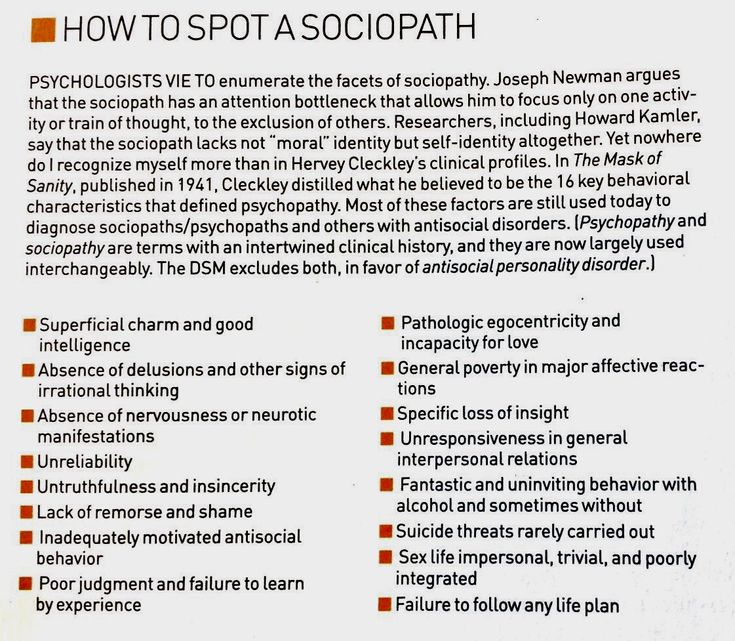 There are 4 personality types in Cluster B:[2] X Research source
There are 4 personality types in Cluster B:[2] X Research source - A person with antisocial personality disorder may have thoughts and actions that defy those in authority. They may also break rules, lack remorse, and even be violent or aggressive.
- A person with borderline personality disorder has low self-esteem that translates into using others for self-validation. They may act paranoid about what others think, make threats, and have a rocky relationship history.
- A person with histrionic personality disorder feels a strong need to be the center of attention. They may act sexually provocative, make threats, and form attachments too quickly.
- A person with narcissistic personality disorder acts with superficial charm and usually lacks emotional empathy. This person may be unable to accept criticism and have a need for admiration. They may exploit others.
-
2
Listen actively to what the person says.
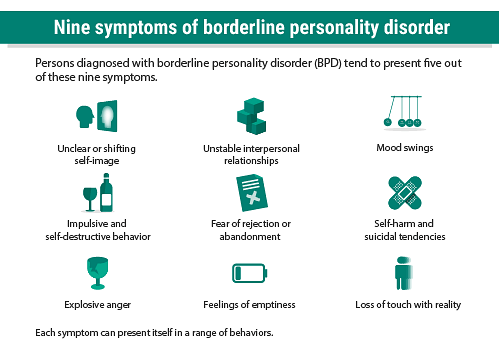 Tuning in to what the person says helps ensure that the interaction will go more smoothly. If they feel ignored or pressured, they may act out. Make occasional eye contact and display open body language that doesn't seem as threatening or abrasive.[3] X Research source
Tuning in to what the person says helps ensure that the interaction will go more smoothly. If they feel ignored or pressured, they may act out. Make occasional eye contact and display open body language that doesn't seem as threatening or abrasive.[3] X Research source - Once they're finished talking, repeat what they said in a new way to be sure you heard it correctly.
-
3
Validate their feelings, even if you don't fully agree or understand. Validation can help affirm what the person is feeling, without necessarily agreeing with them. It can also prevent a tense situation from escalating.[4] X Research source Here are some things you can say:
- "I'm sorry to hear you're going through that. It sounds stressful."
- "It sounds like you're feeling pretty lonely."
- "It's okay to be upset.
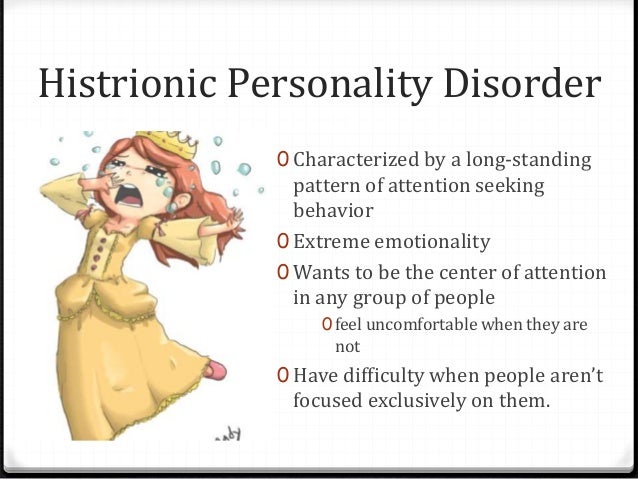 "
" - "Of course you're stressed. You were in a very difficult situation there."
- "I'm here for you."
-
4
Set firm boundaries. Someone with a cluster B personality disorder may struggle with remembering to respect boundaries. They may sometimes act out or seek attention when it's not appropriate. You need to gently and firmly set boundaries to help them understand the expectations. If they don't stop, calmly tell them the consequences (such as you leaving the room) and follow through if needed.[5] X Research source
- "Please don't call me after 8 at night. I use that time to relax with my family and get ready for bed. If you want, you can text me, and I'll see it the next day."
- "I understand you're upset. I am not okay with you yelling at me. If you don't stop, I will leave."
- "Please be gentle with my things. If you break them, then I won't let you borrow them anymore.
 "
" - "If you threaten me again, I will call the police."
-
5
Avoid trying to diagnose someone based on their behavior. If you suspect that they have a disorder, keep that suspicion private. People can only be diagnosed when they have consented to an evaluation from a trained provider. Never throw out labels like “histrionic” or “narcissistic" when talking to or about the person.[6] X Research source
- Cluster B disorders can be stigmatized, sometimes unfairly. You could hurt the person's reputation and cause them to be ostracized.
- Some people with cluster B disorders prefer to keep their conditions private. You could really hurt their feelings if you share a correct suspicion.
Advertisement
-
1
Keep your cool when things get heated. People with cluster B disorders can face extreme mood swings that they may struggle to control.
 You can help by speaking calmly and putting on a calm face (even if you're stressed).[7] X Research source
You can help by speaking calmly and putting on a calm face (even if you're stressed).[7] X Research source - Take a few deep breaths, ask for a timeout, or postpone the discussion for a later time.
- Keep in mind that if you remain grounded and calm, it's easier to de-escalate the situation. However, if you both lose your head, it'll be challenging to resolve the problem.
-
2
Try not to take hurtful words personally. People with cluster B disorders can experience strong mood swings, and they may say things that they don't mean in the heat of the moment. They behave this way because they don't have the social skills to know any better.[8] X Trustworthy Source HelpGuide Nonprofit organization dedicated to providing free, evidence-based mental health and wellness resources. Go to source
- Even when they don't mean it, it can still be hurtful.
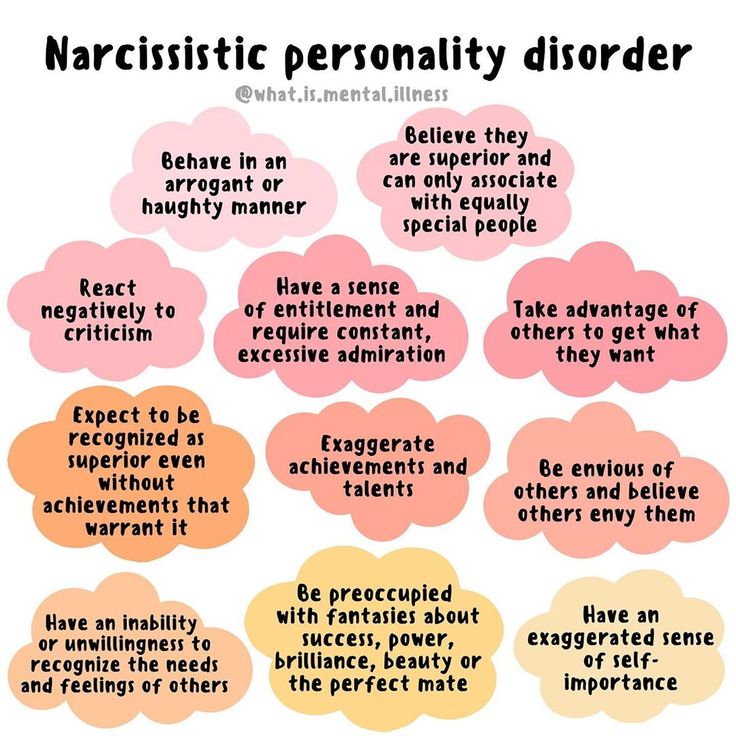 You're allowed to say "That hurts my feelings" or "I'm not okay with you talking to me that way."
You're allowed to say "That hurts my feelings" or "I'm not okay with you talking to me that way." - It's okay to walk away or take some space if you feel upset.
- Even when they don't mean it, it can still be hurtful.
-
3
Avoid criticizing their behavior or minimizing their feelings. If the Cluster B person is already on edge, then criticism will only upset them even more. You might also avoid giving them suggestions or advice, which may “sound” like criticism to them.[9] X Trustworthy Source HelpGuide Nonprofit organization dedicated to providing free, evidence-based mental health and wellness resources. Go to source They need to feel understood, not ignored or controlled. Here are some examples of unhelpful things to say:
- "You're overreacting."
- "Calm down!"
- "It's not a big deal."
- "Just try _____."
- "Why are you so sensitive?"
- "Just get over it.
-
4
Call for help if they threaten suicide.
 Sometimes, a person with a cluster B disorder may say extreme things as a last-ditch attempt at getting their way. But other times, they really do feel suicidal, and they may be in danger of hurting themselves. Call a suicide hotline for assistance.[10] X Research source
Sometimes, a person with a cluster B disorder may say extreme things as a last-ditch attempt at getting their way. But other times, they really do feel suicidal, and they may be in danger of hurting themselves. Call a suicide hotline for assistance.[10] X Research source - If they're in the United States, contact the 988 Suicide and Crisis Lifeline by calling or texting 988 and let the person talk with a representative. This person can help "talk them down" and de-escalate the situation.
- If they use a suicide threat to try to get their way, say "I care about you and want you to be safe. That doesn't change my boundaries. If you really do feel suicidal, I can help you call a hotline or visit the emergency room."
-
5
Walk away if you don't know how to handle things. While you may want to help make things better, it's unlikely to succeed if you don't know how.
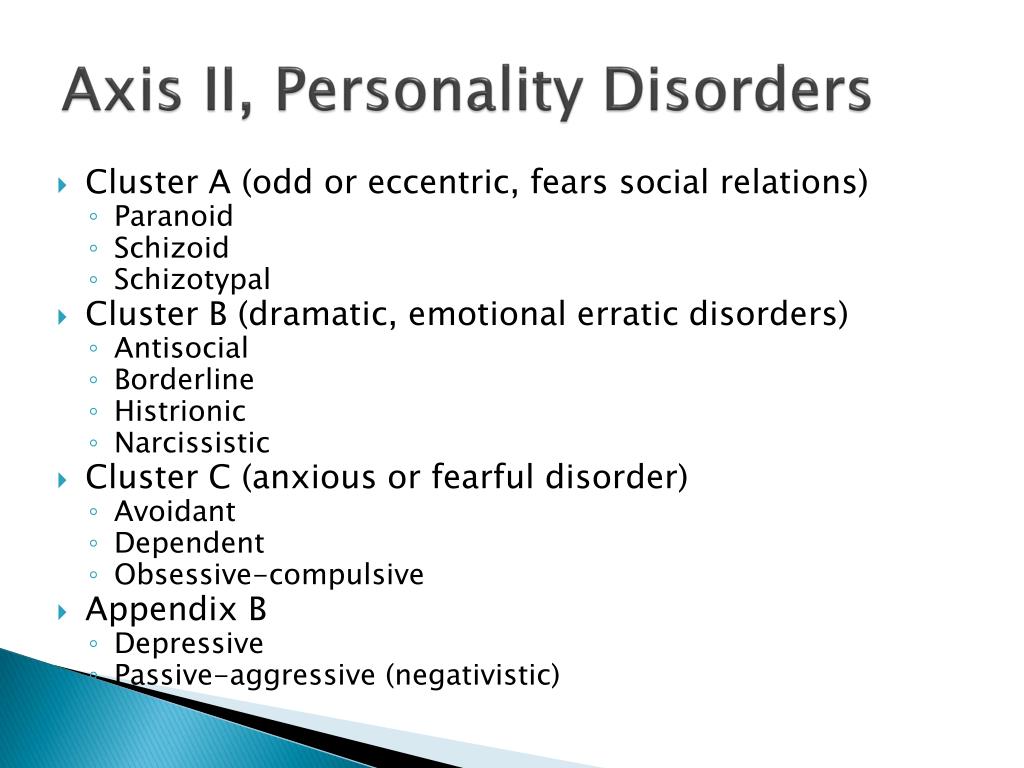 Leave if you feel scared or at your breaking point.[11] X Trustworthy Source HelpGuide Nonprofit organization dedicated to providing free, evidence-based mental health and wellness resources. Go to source Both of you can take time to calm down.
Leave if you feel scared or at your breaking point.[11] X Trustworthy Source HelpGuide Nonprofit organization dedicated to providing free, evidence-based mental health and wellness resources. Go to source Both of you can take time to calm down. - Say "I need to be alone right now so I can calm down."
- If the person threatens to harm themselves or someone else, call local emergency services for help.
Advertisement
-
1
Spend time with people who make you feel good. Strong friendships are important for everyone, and they're essential for people who have a difficult relationship with someone close to them. Build strong relationships with others who can offer you support and stability.[12] X Trustworthy Source HelpGuide Nonprofit organization dedicated to providing free, evidence-based mental health and wellness resources.
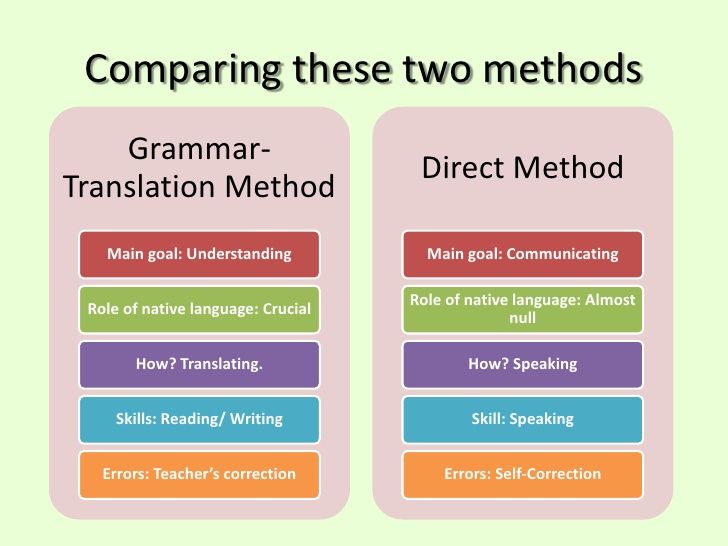 Go to source
Go to source - Dedicate one day out of the week to fun activities with people who cheer you up. Make plans to do something like getting lunch or seeing a movie.
-
2
Practice self-care each day. Self care is important, and it's crucial for people who live with a cluster B loved one. By keeping yourself calm and balanced, you allow yourself to be better able to help them when they need it. Fifteen minutes of "me time" per day is the bare minimum.[13] X Trustworthy Source Mind U.K.-based mental health charity focused on providing advice and resources to anyone facing mental health problems. Go to source Try to get closer to an hour if you can. You could:
- Write in a journal
- Enjoy a warm drink
- Take a long walk with someone you love
- Massage yourself
- Take a hot shower
- Snuggle with a pet or person
- Laugh at a funny video
- Sing along to your favorite songs
-
3
Maintain your sense of self when you're interacting with them.
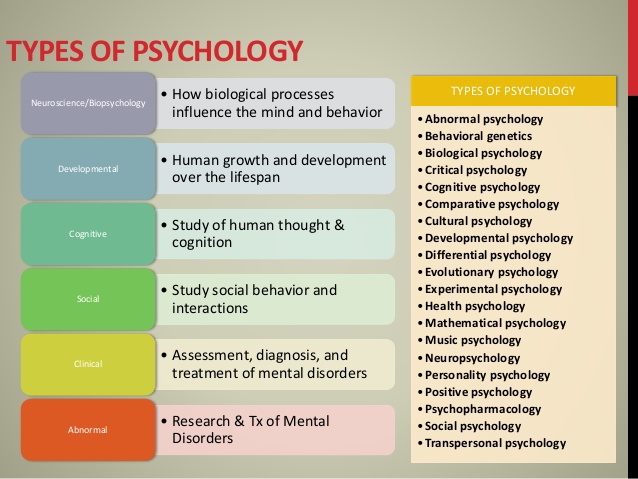 While you may want to spend extra time on helping them, it's important to take time for yourself so that you don't lose your sense of who you are. Here are some ways to keep yourself centered:
While you may want to spend extra time on helping them, it's important to take time for yourself so that you don't lose your sense of who you are. Here are some ways to keep yourself centered: - Write down your big priorities. Make sure you spend time on all of them.
- Write in a journal.
- Make time for your hobbies and favorite things.
- Remember that you can help them, but you can't control them. Don't blame yourself for being unable to fix everything.
-
4
Participate in support groups. Meet with others who regularly interact with a Cluster B person through local support groups. Such groups can help you figure out strategies for dealing with the person and provide an outlet to vent your frustrations.[14] X Research source
- Contact local mental health agencies to locate support groups in your area. You might also receive support virtually through online support groups.

- Contact local mental health agencies to locate support groups in your area. You might also receive support virtually through online support groups.
-
5
Talk to a counselor. A counselor can help you learn new ways to handle the cluster B person's behavior, and they can talk you through your own issues and frustrations. A counselor can serve as an excellent source of support. They can also help you develop coping strategies and learn how to set boundaries with the person.[15] X Trustworthy Source Mayo Clinic Educational website from one of the world's leading hospitals Go to source
- Look up counselors in your area who specifically have experience working with personality disorders.
- In some cases, the counselor may ask your friend or loved one to attend a session to improve communication between you. Only bring the person along if your counselor thinks it's a good idea.
-
6
Manage your expectations moving forward. The traits of people with personality disorders are pervasive and usually lifelong— they won't grow out of them.
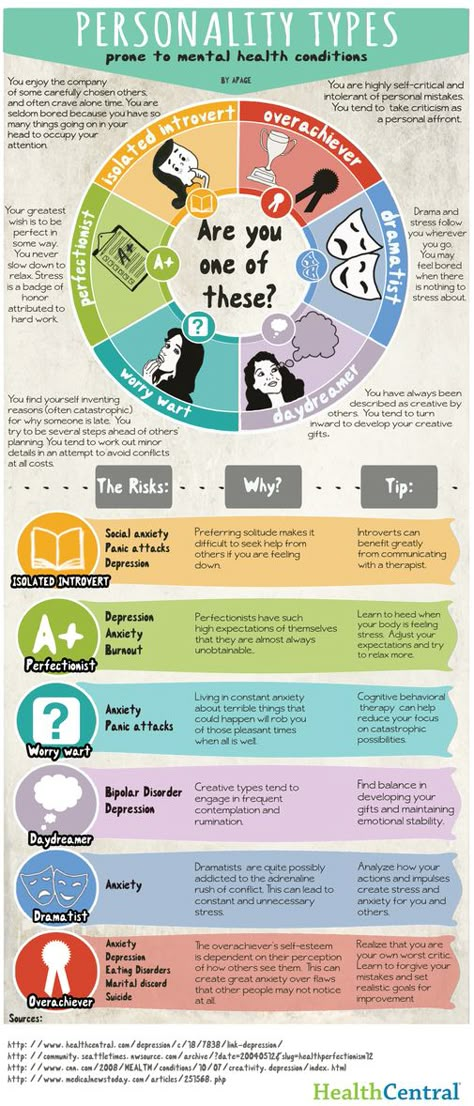 You'll need to adjust your own mindset to make interactions with this person more pleasant in the future.[16] X Research source
You'll need to adjust your own mindset to make interactions with this person more pleasant in the future.[16] X Research source - While people with personality disorders can learn new skills and improve their self-awareness, the disorders themselves aren't going to disappear.
- Learning about the disorder can help you better understand your loved one's thoughts and behavior.
Advertisement
Expert Q&A
Search
Add New Question
Ask a Question
200 characters left
Include your email address to get a message when this question is answered.
Submit
Advertisement
Advertisement
- ↑ https://www.mayoclinic.org/diseases-conditions/personality-disorders/symptoms-causes/syc-20354463
- ↑ https://www.
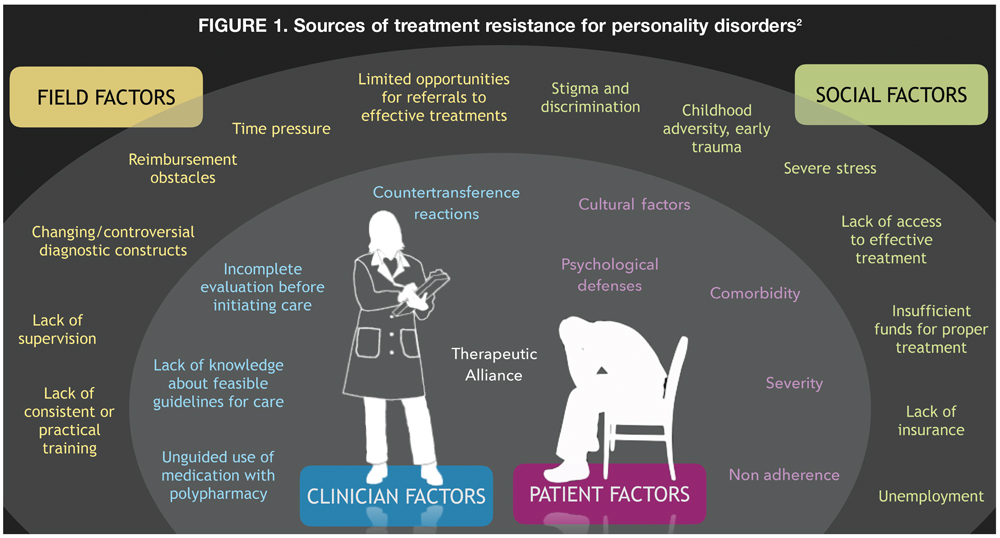 medicalnewstoday.com/articles/320508.php
medicalnewstoday.com/articles/320508.php - ↑ https://www.psychologytoday.com/blog/fulfillment-any-age/201203/11-ways-active-listening-can-help-your-relationships
- ↑ https://psychcentral.com/lib/how-to-help-a-loved-one-with-borderline-personality-disorder-part-2/
- ↑ https://www.psychologytoday.com/us/basics/cluster-b
- ↑ https://www.medicalnewstoday.com/articles/320508.php
- ↑ https://www.psychologytoday.com/us/basics/cluster-b
- ↑ https://www.helpguide.org/articles/mental-disorders/narcissistic-personality-disorder.htm
- ↑ https://www.helpguide.org/articles/mental-disorders/narcissistic-personality-disorder.htm
- ↑ https://www.opencounseling.com/suicide-hotlines
- ↑ https://www.helpguide.org/articles/mental-disorders/helping-someone-with-borderline-personality-disorder.htm
- ↑ https://www.helpguide.org/articles/mental-disorders/narcissistic-personality-disorder.htm
- ↑ https://www.
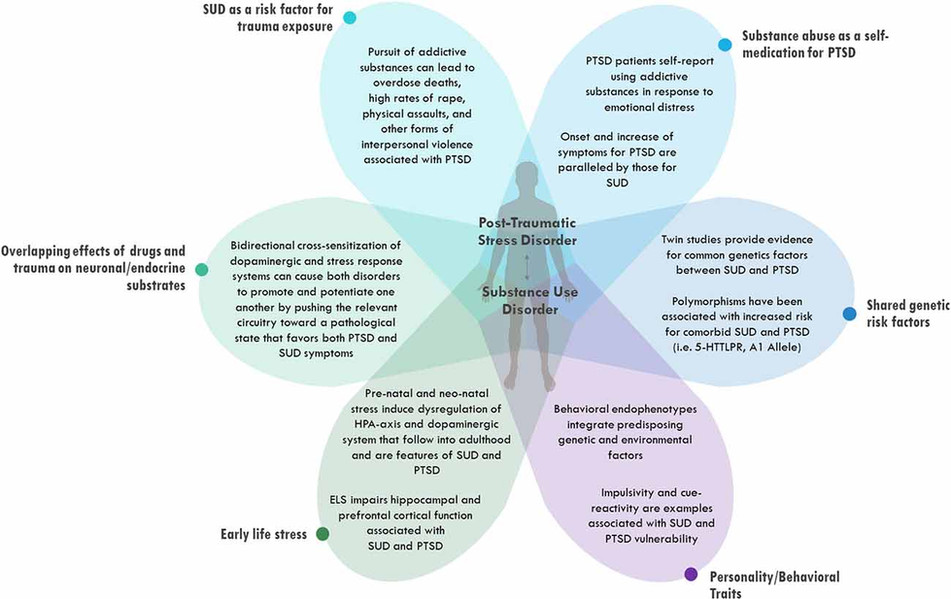 mind.org.uk/information-support/types-of-mental-health-problems/borderline-personality-disorder-bpd/for-friends-and-family/#.Wn_STHRMHqA
mind.org.uk/information-support/types-of-mental-health-problems/borderline-personality-disorder-bpd/for-friends-and-family/#.Wn_STHRMHqA - ↑ https://psychcentral.com/lib/how-to-help-a-loved-one-with-borderline-personality-disorder-part-2/
- ↑ https://www.mayoclinic.org/diseases-conditions/personality-disorders/diagnosis-treatment/drc-20354468
- ↑ https://psychcentral.com/lib/how-to-help-a-loved-one-with-borderline-personality-disorder-part-2/
About This Article
In other languages
- Send fan mail to authors
Thanks to all authors for creating a page that has been read 44,625 times.
Reader Success Stories
-
Dawn Seymour
Oct 10, 2018
"my daughter was diagnosed with Cluster B Disorder 10 years ago, and her life has been dramatic and troubled ever since. This article made me realize I need to take a step back and look after myself a bit more.
 "..." more
"..." more
More reader stories Hide reader stories
Share your story
Advertisement
Group B personality disorders: features, treatment and more
contents
Overview
Personality disorders are a type of mental health condition. They can lead to permanent, long-term, and unhealthy patterns of thinking, feeling, and behaving.
There are three main groups of personality disorders: Cluster A, Cluster B, Cluster C.
Each cluster has several unique properties that are used to classify symptoms. Within three clusters, 10 personality disorders are grouped. There are four personality disorders in cluster B, including:
- antisocial personality disorder
- borderline personality disorder
- histrionic personality disorder
- narcissistic personality disorder
Personality disorders from different groups can be diagnosed.
characteristics
Each personality disorder has its own unique symptoms or characteristics. According to the fifth edition of the Diagnostic and Statistical Manual of Mental Disorders (DSM-5), symptoms should:
According to the fifth edition of the Diagnostic and Statistical Manual of Mental Disorders (DSM-5), symptoms should:
- have a seizure in adolescence or early adulthood
- be stable over time
- lead to personality problems or impairment
Antisocial personality disorder
People with antisocial personality disorder exhibit disrespect and violations of other rights. Anger and manipulation are used for personal gain. They may mistreat other people, lie, or cheat for these personal gains. They are also more prone to stealing. However, as a rule, they do not repent of their deeds. nine0003
People with antisocial personality disorder also have an increased risk of drug or alcohol addiction.
Borderline personality disorder
People with borderline personality disorder often have unstable personal relationships. It can also affect how you view yourself. Symptoms include:
- impulsive behavior
- chronic feelings of emptiness
- chronic feelings of abandonment
- intense rage attacks
- reckless behavior
People with this disorder may also exhibit suicidal behavior.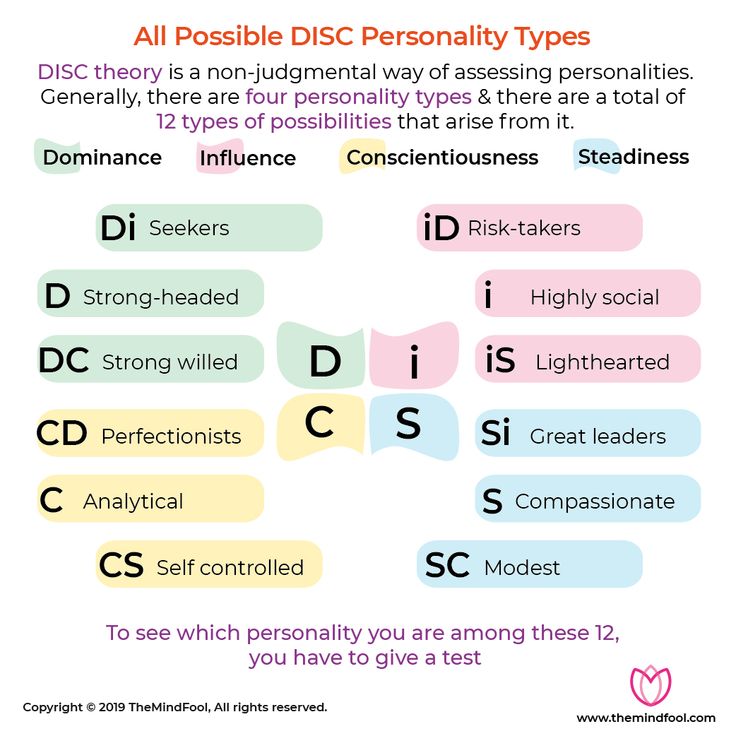
Read more: Please don't get me wrong, I have borderline personality disorder »
Histrionic Personality Disorder
People with Histrionic Personality Disorder often strive to be the center of attention. They may engage in a variety of attention-demanding behaviors, often in socially unacceptable situations. This behavior may include:
- provocative interactions
- theatrics
- false sense of closeness
People with this disorder have an increased risk of suicidal gestures.
Read more: Understanding why people cut themselves off, hide and how to help themselves »
Narcissistic Personality Disorder
People with this personality disorder believe they are superior to others. Symptoms include:
- extremely negative reaction to criticism
- heightened self-esteem
- preoccupation with grandiose thoughts of success
- excessive need for admiration
- strong sense of entitlement
People with this disorder often exhibit a lack of empathy and may use personal relationships to improve their self-esteem.
Causes and risk factors
Personality disorders are likely caused by a combination of genetics and environmental factors.
Jedan study she found a strong association between borderline personality disorder and a history of sexual trauma. More studying, they found an association between children who were verbally abused by their mothers and various personality disorders, including borderline and narcissistic personality disorders.
A recent review also found similarities in the anatomical features of the brains of people with personality cluster B. This suggests that brain development may also contribute to these disorders. nine0003
Ostrazhivanye found a significant association between cluster B personality disorder and family history. Having parents or siblings with a personality disorder increases the risk of developing the disorder.
Diagnosis
It is important not to diagnose yourself or others if you see signs of a personality disorder.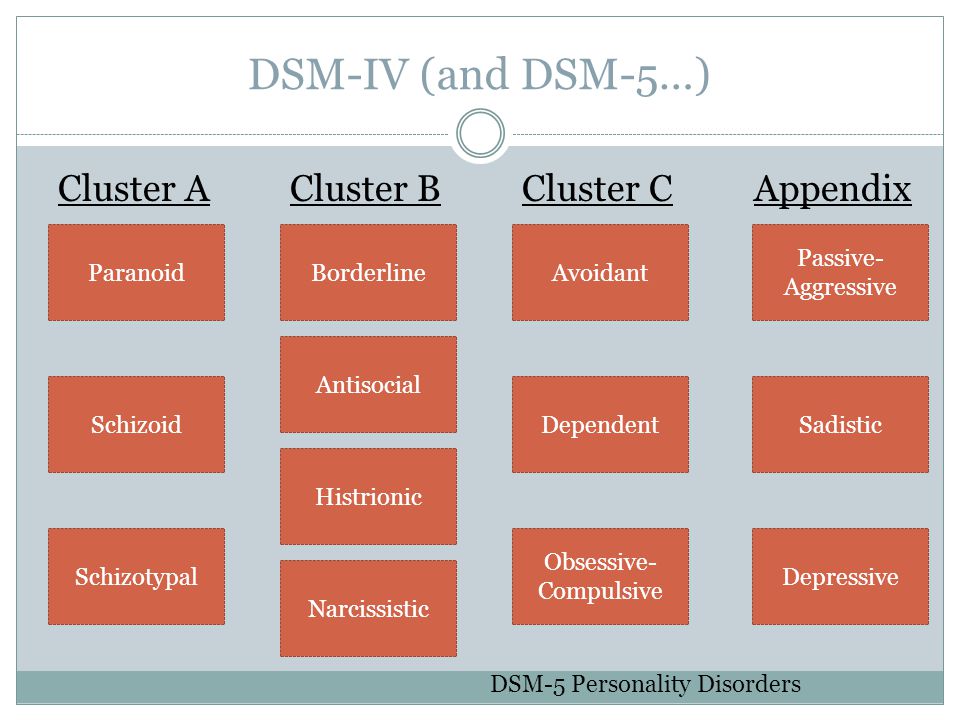 A personality disorder should only be diagnosed by a qualified mental health professional.
A personality disorder should only be diagnosed by a qualified mental health professional.
Mental health professionals use the DSM-5 to diagnose personality disorders and other mental health conditions. To be diagnosed, people must meet the criteria listed for the specific disorder. nine0003
You will probably need to have several sessions with a therapist before being officially diagnosed. During your meeting, they will ask you various questions about your life, many of which may make you feel very personal. It is important to be open and honest with your mental health professional. This will help them make an accurate diagnosis.
According to the DSM-5, you must meet the following requirements to be diagnosed with Cluster B Personality Disorder:
- Symptoms first appeared in early adulthood.
- If you are under 18, you must have had symptoms for at least one year.
- Symptoms must not be the result of other disorders or specific stressful situations.
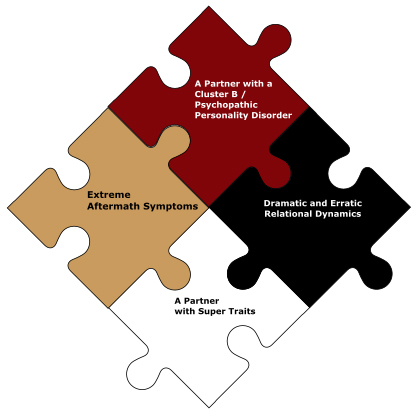
Your doctor may want to talk to family members to help you understand your symptoms. This is because it can be difficult to recognize the symptoms in oneself. Your doctor will not share what you have told them with your family members, nor will he share with you what your family members have shared. nine0003
treatment
Treatment will likely involve a variety of methods and will require your commitment. Your doctor may recommend trying something new during treatment. And you may need to continue seeing your doctor even after your symptoms improve.
Psychotherapy
Psychotherapy is usually a key part of any treatment plan. This is sometimes called talking therapy.
During psychotherapy, you will have the opportunity to express your thoughts and feelings in a non-judgmental environment. People with Group B personality disorders may find it difficult to establish a comfortable relationship with a therapist. You should not take this as a sign that the therapy is not working.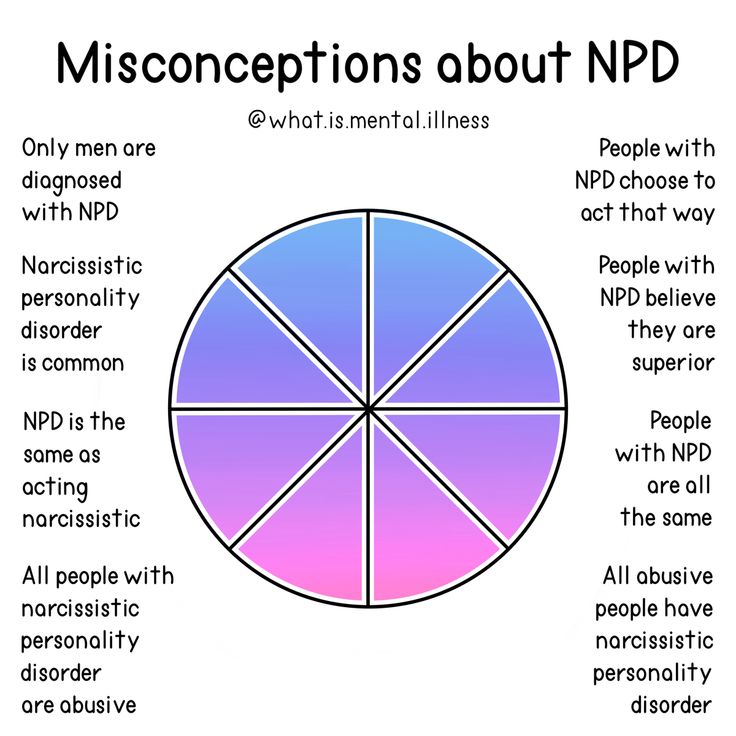 nine0003
nine0003
Your doctor may recommend both dialectical behavior therapy (DBT) and cognitive behavioral therapy (CBT).
DBT is used to teach new skills and encourage change. It can be group or individual lessons.
CBT focuses on problem solving and teaches skills to identify problematic thoughts and beliefs.
Care
There are no drugs approved by the US Food and Drug Administration for the treatment of personality disorders. Some medicines may be helpful if your doctor uses them to suppress some of the symptoms, or to treat a psychiatric or psychiatric disorder that occurs at the same time. The most commonly used medications include:
- mood stabilizers
- antidepressants
- antipsychotics
- anti-anxiety drugs
Talk to your doctor about possible side effects and let him know if your symptoms do not improve or worsen. You should also avoid using drugs or alcohol while taking these medicines as they may increase the risk of side effects.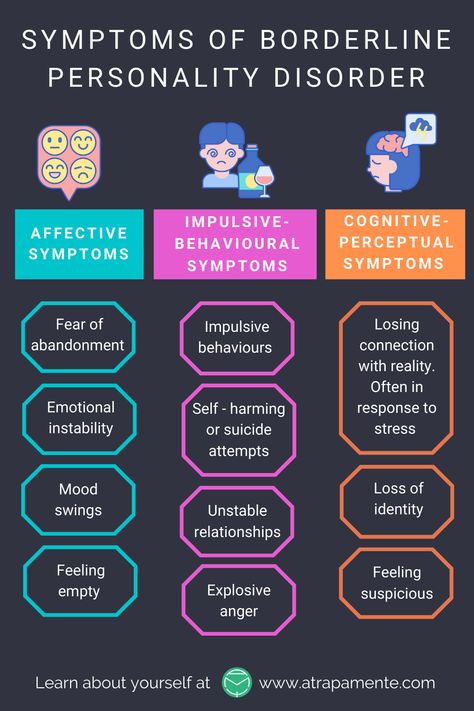
Helping a loved one
If a family member or friend has been diagnosed with a personality disorder, be supportive and open. Tell them impartially when they violate your boundaries. They may not always fight for social cues, but a little guidance can help them identify behaviors that may be affecting their condition. nine0003
If you think a person with group B symptoms is a danger to themselves or others, call your local emergency services.
downtrodden
People with cluster B personality disorders often have difficulty maintaining healthy relationships and may exhibit emotional and impulsive symptoms. Treatment for this condition is possible with medication, although you may need a combination of treatments, including therapy and, in some cases, medication. nine0003
Suicide Prevention
If you think someone is in imminent danger of harming themselves or harming another person:
- Call 911 or your local emergency number.
- Stay with the person until help arrives.
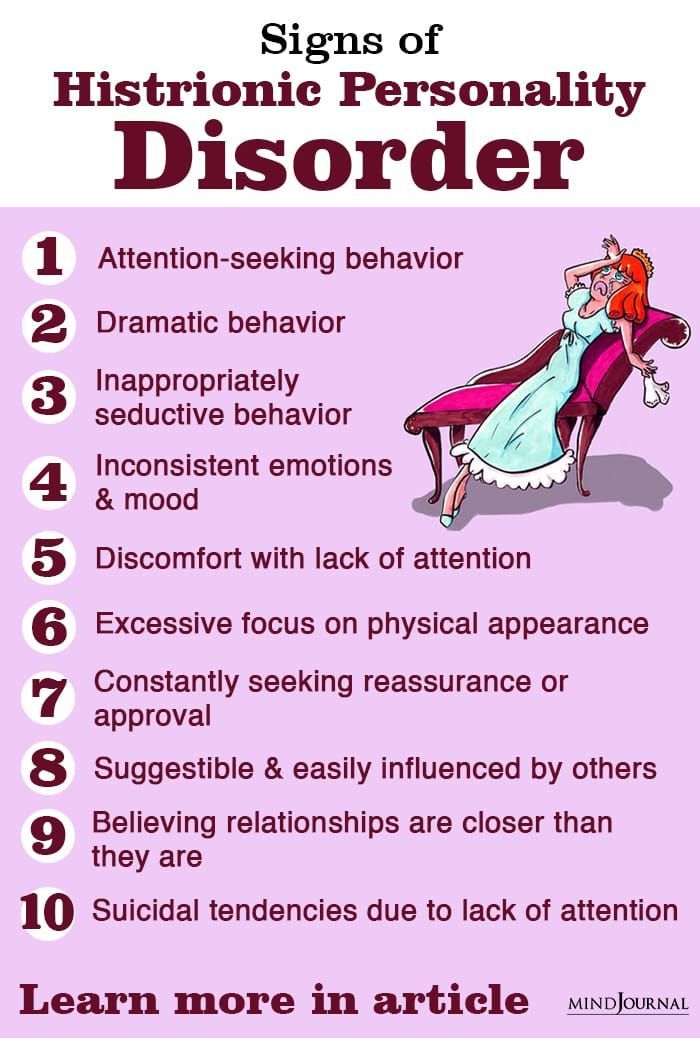
- Remove all weapons, knives, medicines, or other items that could cause damage.
- Listen, but don't judge, argue, threaten or yell. nine0014
If you think someone is thinking about suicide, seek crisis help or a suicide prevention hotline. Contact the National Suicide Prevention Center at 800-273-8255.
Sources: National Suicide Prevention i Department of Drug Abuse and Mental Health Services
Group B personality disorders: features, treatment and more
content
Overview
Personality disorders are a type of mental health condition. They can lead to permanent, long-term, and unhealthy patterns of thinking, feeling, and behaving.
There are three main groups of personality disorders: Cluster A, Cluster B, Cluster C.
Each cluster has several unique properties that are used to classify symptoms. Within three clusters, 10 personality disorders are grouped. There are four personality disorders in cluster B, including:
- antisocial personality disorder
- borderline personality disorder
- histrionic personality disorder
- narcissistic personality disorder
Personality disorders from different groups can be diagnosed.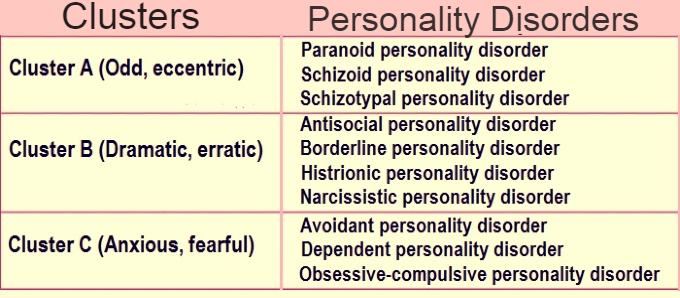
characteristics
Each personality disorder has its own unique symptoms or characteristics. According to the fifth edition of the Diagnostic and Statistical Manual of Mental Disorders (DSM-5), symptoms should:
- have a seizure in adolescence or early adulthood
- be stable over time
- lead to personality problems or impairment
Antisocial personality disorder
People with antisocial personality disorder exhibit disrespect and violations of other rights. Anger and manipulation are used for personal gain. They may mistreat other people, lie, or cheat for these personal gains. They are also more prone to stealing. However, as a rule, they do not repent of their deeds. nine0003
People with antisocial personality disorder also have an increased risk of drug or alcohol addiction.
Borderline personality disorder
People with borderline personality disorder often have unstable personal relationships.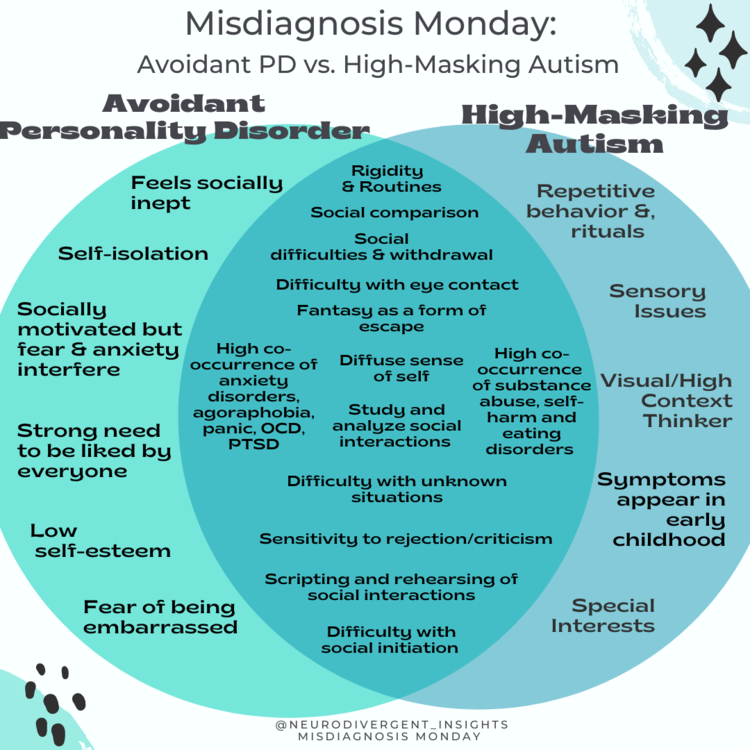 It can also affect how you view yourself. Symptoms include:
It can also affect how you view yourself. Symptoms include:
- impulsive behavior
- chronic feelings of emptiness
- chronic feelings of abandonment
- intense rage attacks
- reckless behavior
People with this disorder may also exhibit suicidal behavior.
Read more: Please don't get me wrong, I have borderline personality disorder »
Histrionic Personality Disorder
People with Histrionic Personality Disorder often strive to be the center of attention. They may engage in a variety of attention-demanding behaviors, often in socially unacceptable situations. This behavior may include:
- provocative interactions
- theatrics
- false sense of closeness
People with this disorder have an increased risk of suicidal gestures.
Read more: Understanding why people cut themselves off, hide and how to help themselves »
Narcissistic Personality Disorder
People with this personality disorder believe they are superior to others. Symptoms include:
Symptoms include:
- extremely negative reaction to criticism
- heightened self-esteem
- preoccupation with grandiose thoughts of success
- excessive need for admiration
- strong sense of entitlement
People with this disorder often exhibit a lack of empathy and may use personal relationships to improve their self-esteem.
Causes and risk factors
Personality disorders are likely caused by a combination of genetics and environmental factors.
Jedan study she found a strong association between borderline personality disorder and a history of sexual trauma. More studying, they found an association between children who were verbally abused by their mothers and various personality disorders, including borderline and narcissistic personality disorders.
A recent review also found similarities in the anatomical features of the brains of people with personality cluster B. This suggests that brain development may also contribute to these disorders.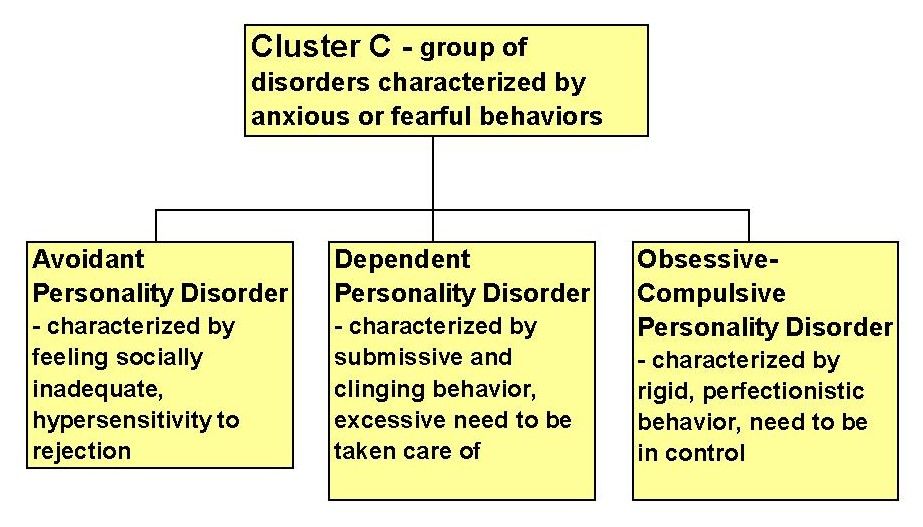 nine0003
nine0003
Ostrazhivanye found a significant association between cluster B personality disorder and family history. Having parents or siblings with a personality disorder increases the risk of developing the disorder.
Diagnosis
It is important not to diagnose yourself or others if you see signs of a personality disorder. A personality disorder should only be diagnosed by a qualified mental health professional.
Mental health professionals use the DSM-5 to diagnose personality disorders and other mental health conditions. To be diagnosed, people must meet the criteria listed for the specific disorder. nine0003
You will probably need to have several sessions with a therapist before being officially diagnosed. During your meeting, they will ask you various questions about your life, many of which may make you feel very personal. It is important to be open and honest with your mental health professional. This will help them make an accurate diagnosis.
According to the DSM-5, you must meet the following requirements to be diagnosed with Cluster B Personality Disorder:
- Symptoms first appeared in early adulthood.
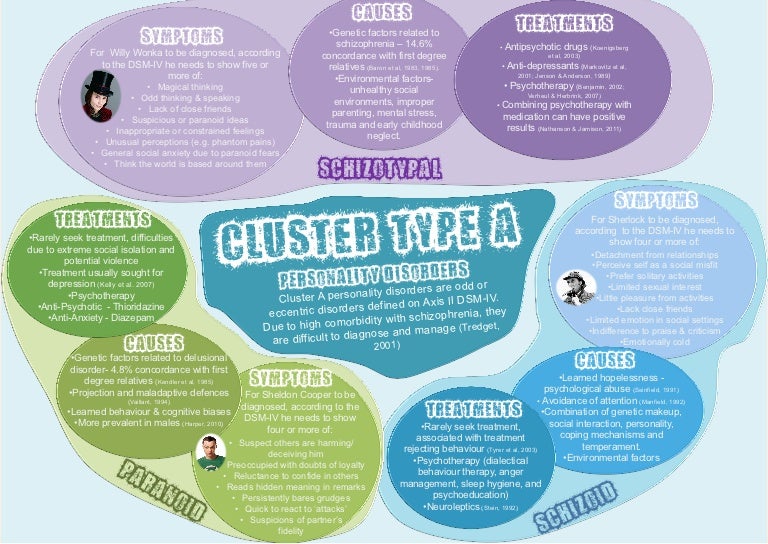
- If you are under 18, you must have had symptoms for at least one year.
- Symptoms must not be the result of other disorders or specific stressful situations.
Your doctor may want to talk to family members to help you understand your symptoms. This is because it can be difficult to recognize the symptoms in oneself. Your doctor will not share what you have told them with your family members, nor will he share with you what your family members have shared. nine0003
treatment
Treatment will likely involve a variety of methods and will require your commitment. Your doctor may recommend trying something new during treatment. And you may need to continue seeing your doctor even after your symptoms improve.
Psychotherapy
Psychotherapy is usually a key part of any treatment plan. This is sometimes called talking therapy.
During psychotherapy, you will have the opportunity to express your thoughts and feelings in a non-judgmental environment.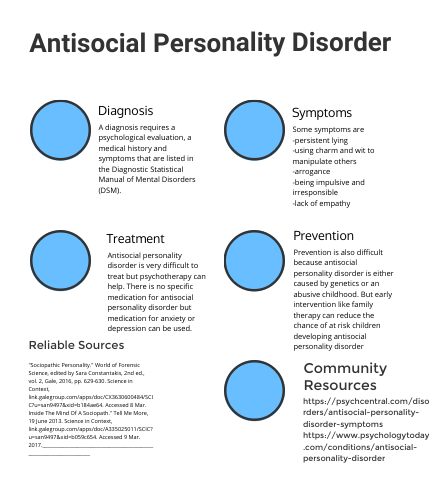 People with Group B personality disorders may find it difficult to establish a comfortable relationship with a therapist. You should not take this as a sign that the therapy is not working. nine0003
People with Group B personality disorders may find it difficult to establish a comfortable relationship with a therapist. You should not take this as a sign that the therapy is not working. nine0003
Your doctor may recommend both dialectical behavior therapy (DBT) and cognitive behavioral therapy (CBT).
DBT is used to teach new skills and encourage change. It can be group or individual lessons.
CBT focuses on problem solving and teaches skills to identify problematic thoughts and beliefs.
Care
There are no drugs approved by the US Food and Drug Administration for the treatment of personality disorders. Some medicines may be helpful if your doctor uses them to suppress some of the symptoms, or to treat a psychiatric or psychiatric disorder that occurs at the same time. The most commonly used medications include:
- mood stabilizers
- antidepressants
- antipsychotics
- anti-anxiety drugs
Talk to your doctor about possible side effects and let him know if your symptoms do not improve or worsen.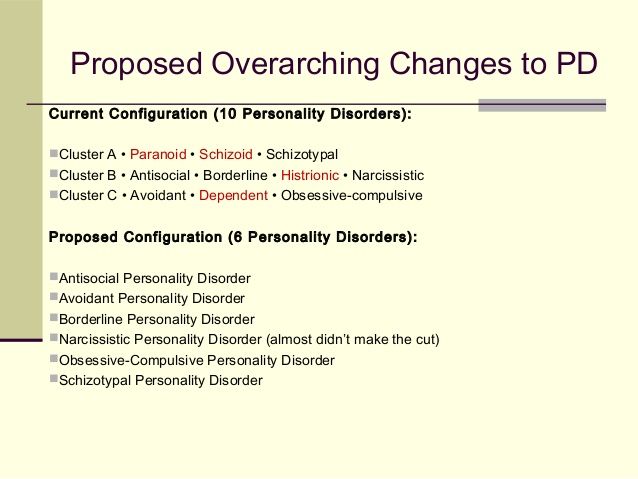 You should also avoid using drugs or alcohol while taking these medicines as they may increase the risk of side effects.
You should also avoid using drugs or alcohol while taking these medicines as they may increase the risk of side effects.
Helping a loved one
If a family member or friend has been diagnosed with a personality disorder, be supportive and open. Tell them impartially when they violate your boundaries. They may not always fight for social cues, but a little guidance can help them identify behaviors that may be affecting their condition. nine0003
If you think a person with group B symptoms is a danger to themselves or others, call your local emergency services.
downtrodden
People with cluster B personality disorders often have difficulty maintaining healthy relationships and may exhibit emotional and impulsive symptoms. Treatment for this condition is possible with medication, although you may need a combination of treatments, including therapy and, in some cases, medication. nine0003
Suicide Prevention
If you think someone is in imminent danger of harming themselves or harming another person:
- Call 911 or your local emergency number.
